Featured Application
Electrochemical disinfection may revolutionize endodontics and is shown here to not damage host tissue.
Abstract
Boron-doped diamond (BDD) electrodes have been advocated as a potential treatment alternative to the established methods for root canal disinfection. As healing of periapical tissue is important in this context, the associated risk of host tissue damage was to be evaluated. Following in vitro cell culture experiments (HeLa cells), root canal treatment was performed in an animal trial comparing BDD electrode application and the currently used rinsing media with respect to cell viability and host tissue damage. Statistical analyses comparing the size of radiolucency were based on Kruskal-Wallis and Nemenyi’s All Pairs tests (α = 0.05). The direct application of BDD electrodes had a time-dependent effect on cell viability comparable to H2O2, NaOCl, and CHX application. In contrast to the chemical treatment, the effect of BDD electrodes was transient. Conventionally treated teeth and teeth additionally treated with BDD electrodes did not significantly differ from each other with respect to the size of the periapical radiolucency as observed radiographically (vertical p = 0.998 and horizontal p = 0.878) and histologically (vertical p = 0.940 and horizontal p = 0.862). While showing greater disinfection efficiency, the application of BDD electrodes for the electrochemical disinfection of root canals does not have a greater risk of host tissue damage compared to the conventional treatment.
1. Introduction
The ultimate goal of endodontic treatment is the healing of periapical radiolucency resulting from previous inflammation [1], leading to the definition of a successful treatment by the absence of apical periodontitis and clinical symptoms after a period of observation [2]. In order to achieve that, the steps of canal debridement, effective disinfection, and obturation/placement of a coronal seal have to be followed [3]. While whether root canal obturation is necessary for apical healing may be argued [3,4], there seems to be a consensus that proper disinfection of the canal system and the remaining dentin is crucial [5]. Root canal morphology, with all of its numerous variations, has been identified as being critical in this context [6], and in response to that e.g., the use of electric pulses for eliminating residues of pulp tissue and inorganic debris [7] has been advocated for to optimize current treatment protocols.
Treating dental implants affected by peri-implantitis constitutes a situation which is comparable to disinfecting a porous root canal system, as hardly accessible, roughed surfaces have to be disinfected [8]. As a novel approach for this indication, applying an electric current for the simple electrolysis of water using already installed metallic dental implants as electrodes has been introduced [9,10,11,12,13]. A newer study on the clinical application of this technology reported that the re-osseointegration of implants following electrochemical treatment and augmentation was possible [14], which may indicate that electrochemical treatment per se does not harm host tissue.
A more specific approach of using electrochemical disinfection applies to boron-doped diamond (BDD) electrodes and has been shown to effectively inactivate bacterial biofilm on dental implant surfaces and in root canals [15]. The working principle of BDD electrodes is the formation of OH radicals and its subsequent reaction products acting as potent, transient, but also unspecific disinfecting agents [16]. The application of these electrodes in the future may follow conventional instrumentation of root canals. Prior to clinical application, the potential risk of host tissue damage by applying electrochemical disinfection must be estimated. It was the goal of this combination of in vitro cell culture experiments and animal trials (reported according to the PRIASE 2021 checklist and flowchart [17]; see Supplementary Materials) to compare BDD electrode application and the currently applied rinsing media with respect to cell viability and host tissue damage.
2. Materials and Methods
2.1. Cell Culture
HeLa cells were cultured in Dulbecco’s modified Eagle’s medium (DMEM), high glucose with L-glutamine (PAA Laboratories), supplemented with 100 mg mL−1 gentamicin, 12 mg mL−1 ciprofloxacin, and 10% of heat-inactivated fetal calf serum (FCS) in a CO2 incubator. Cells were passaged at a ratio of 1:5 twice per week. For the risk assessment assay, HeLa cells, cultivated in 48 well plates at a confluent cell density of 0.12 × 106, were treated as described in Table 1. For all electrode experiments, previously described structured ceramic BDD electrodes were applied [18]. For direct application, an electrode with an active surface of 3 × 4 mm was used in two modes: (i) potentiostatic at 6–9 V with increments of 1 V for 2.5 min (resulting in 2 to 35 mA); (ii) amperostatic for 5 min at 50 mA (6–7 V). For indirect application, an electrode with an active surface of 6 × 8 mm was mounted to the bottom of a UV/Vis cuvette. A current of 50 mA at 10 to 12 V was applied to 3 mL of PBS for indirect application. A conventional laboratory power supply was used for running the electrodes. An Alamar Blue assay (Alamar Blue HS, Invitrogen, Fisher Scientific, Wesel, Germany) was performed according to the manufacturer’s instructions.

Table 1.
Overview of experimental groups and details of treatments rendered during cell culture experiments.
2.2. Analysis of Endodontic Treatment
2.2.1. Animal Experiment
Following the ethics commission approval (Comitetului de Etica a Cercetarii, State Medical and Pharmaceutical University “Nicolae Testemitanu”, Chisinau, Moldova), four dogs (breed: Jack Russel Terrier) with a minimum age of 24 months were allocated for this study [15,19]. All of the animals underwent two interventions which consisted of trepanation [19] of the selected maxillary incisors (combined with the bilateral extractions of mandibular premolars and molars; experiment not reported here), followed by root canal treatment of the infected and non-infected teeth three weeks later (combined with bone augmentation procedures in the mandible; not reported here). The animal experiment basically followed the protocol established by Sabeti et al., 2006 [4], but with shorter observation time in order to not miss the initial host tissue reactions.
General anesthesia was induced and maintained using an intravenously administered combination of Xylacin (Xyla 20 mg mL−1, 0.15 mL kg−1, Interchemie werken ‘De Adelaar’, Waalre, The Netherlands) and Ketamin (Ketamin-hameln 50 mg mL−1, 0.1 mL kg−1, hameln pharma plus GmbH, Hameln, Germany). The heart rate, respiratory rate, O2 saturation, and expiratory CO2 were monitored throughout all the surgical procedures (Low Flow Capnograph V900040LF, SurgiVet Inc., Waukesha, WI, USA). Upon finishing the interventions, atipamezole hydrochloride was administered for the recovery of the animals (Antimedin, ZOOFARMAGRO SRL, Chişinău, Moldova). Local anesthetic was applied (UDS Forte, Sanofi, Frankfurt am Main, Germany) prior to any intervention, followed by intraoral disinfection using chlorhexidine (Chlorhexamed FORTE alkoholfrei 0.2%, GlaxoSmithKline Consumer Healthcare, Munich, Germany). The animals were kept as a group in a controlled facility and were fed with soft food and water ad libitum.
The root canal treatment of maxillary incisors was carried out by applying conventional chemo-mechanical protocols using Hedstroem files and a chlorhexidine solution for rinsing. Intraoral radiographs (60 kV, 7 mA, 0.5 s; Heliodent, Dentsply Sirona, York, PA, USA; Ergonom X, Dentalfilm, Settimo Torinese, Italy) were used for determining working lengths. In addition to the treatment described (groups “conventional”), BDD electrodes (Figure 1) were applied in some of the teeth following chemo-mechanical treatment (group “BDD”).
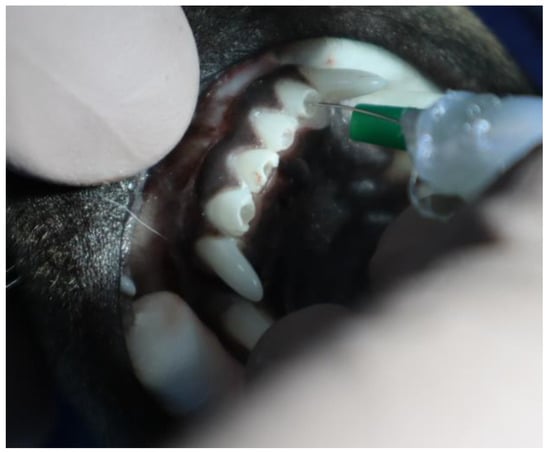
Figure 1.
Situation during endodontic treatment of incisors in a dog model with a prototype of the BDD electrodes being positioned inside a root canal.
The parameters used with the BDD electrodes are detailed in Table 2. Microbial sampling was conducted during endodontic treatment and has already been reported [15]. No root canal obturation was performed, but the access cavities were either restored with a composite resin (groups “sealed”) or left unrestored (groups “open”). Untreated teeth were analyzed as a control (group “untouched”).

Table 2.
Parameters applied during electrochemical disinfection of root canals using BDD electrodes.
2.2.2. X-ray Analysis and Histology
Six weeks after the second intervention, the animals were sacrificed via injection of a T-61 Euthanasia Solution (0.12 mL kg−1; Merck Animal Health, Madison, NJ, USA) after inducing general anesthesia, as described above, and the block sections of both jaws were harvested (experiments conducted in the mandibles are not reported here). Occlusal radiographs were obtained (60 kV, 7 mA, 0.5 s; Heliodent, Dentsply Sirona; Dürr Vista Scan Image Plates Plus, Dürr Dental, Bietigheim-Bissingen, Germany) and the bone specimens were fixed in 10% of neutral-buffered formalin prior to a reduction to rectangular blocks containing the study sites using a diamond band saw (EXAKT 300, EXAKT Advanced Technologies GmbH, Norderstedt, Germany). Subsequently, the specimens were dehydrated in alcohol solutions of increasing concentrations, clarified in xylene and embedded in polymethylmethacrylate (Technovit 9100, Heraeus Kulzer, Hanau, Germany). One labio-lingual section, parallel to the long axis of the teeth, was obtained per specimen by a cutting and grinding technique [20], reduced to a thickness of 70 µm and stained with toluidine blue O solution after preprocessing in 10% of H2O2 solution. Histomorphometric analysis was performed using a microscope (LEICA DM4B, LEICA Mikrosysteme Vertrieb GmbH, Wetzlar, Germany) equipped with a color image analyzing system (LEICA Application Suite, LEICA Phase Expert, LEICA Mikrosysteme Vertrieb GmbH). In addition, the occlusal radiographs obtained prior to histologic processing were imported and analyzed (Figure 2 and Figure 3). For all of the teeth considered, the extent of the periapical radiolucency was determined in the horizontal and vertical directions. The width of the respective roots was measured as a reference system expressing radiolucency using percentages.

Figure 2.
Occlusal radiograph with maxillary anterior teeth. For evaluation of periapical radiolucency, the width of the roots in the apical third was determined (blue arrow), as well as the vertical (red arrow) and the horizontal (yellow arrow) dimensions of the defects. Note: For visibility, the measurements are shown on different teeth here.
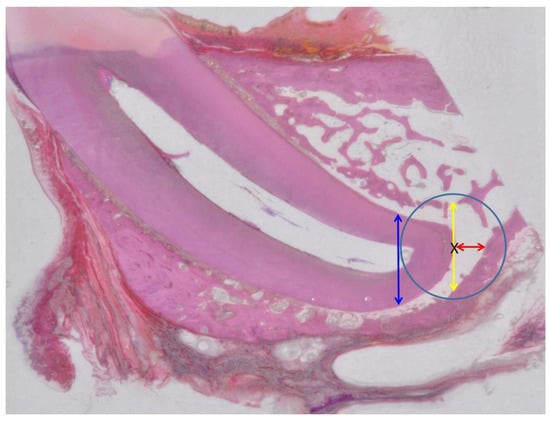
Figure 3.
Typical histologic section used for determining the extent of periapical radiolucency. The apex of the tooth was marked (black X) and a tangent was drawn for measuring the width of the radiolucency (yellow arrow), while a perpendicular line (red arrow) indicated the height of the radiolucency. A circle with a radius of 5 mm surrounding the apex was utilized for measuring the width of the root (blue arrow).
2.2.3. Statistical Analysis
Statistical analyses comparing the size of radiolucency in the different experimental groups were based on Kruskal–Wallis tests and Nemenyi’s All-Pairs tests, with the level of significance set at α = 0.05.
3. Results
3.1. Risk Assessment Using Cell Lines
As a first approach to studying the putative detrimental effects of BDD electrode treatment, the viability of epithelial cells was measured using the Alamar Blue assay, which is based on the reduction in oxidized non-fluorescent blue resazurin to a red fluorescent dye resorufin using the mitochondrial respiratory chain in live cells. Also, as BDD electrode treatment or irrigation solutions may influence this reaction, a cell-free control was always carried out in parallel for this approach and cells were washed three times with PBS before the Alamar Blue assay was carried out.
Confluent cell layers were treated with BDD electrodes at different voltages, amperes, and time intervals, as described in Table 1. The results of the cell viability assay with respect to this treatment are shown in Figure 4a. In summary, the direct application of BDD electrodes had a time-dependent effect on cell viability with longer treatment times causing more cell damage. To compare this effect with conventional treatment protocols, different standard solutions for root canal disinfection were added to the epithelial cell layers in the cell culture wells and incubated for 5 min. H2O2, NaOCl, and CHX application had comparably negative effects on cell viability even after a ten-fold dilution in PBS (Figure 4b). In contrast to the chemical treatment, the effect of BDD electrodes in producing oxidative species, which may harm the epithelial cells, is transient as the use of pretreated PBS buffer solution led to more surviving cells compared to a direct BDD application.
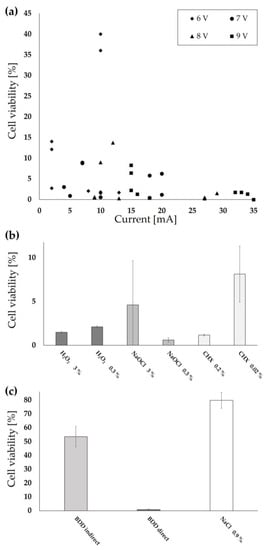
Figure 4.
Results of cell viability assay for the treatments detailed in Table 1. The mean of confluent and PBS-treated cells was set at 100% value. Panel (a) shows the cell viability of HeLa cells after a potentiostatic treatment with a 3 × 4 mm electrode immersed in PBS overlaying the cells (direct treatment) for 2.5 min. Panel (b) contains the outcome of cell treatment with different commercial irrigants frequently used in dental treatment and their ten-fold dilutions in PBS for five minutes. Panel (c) compares direct and indirect treatment of cells and the effect of a treatment with physiological NaCl as a potential electrolyte in comparison to PBS. Note the different scale used for cell viability in panels (a–c).
3.2. Evaluation of Animal Experiment
Four dogs were treated in the frame of the animal experiment as it was carried out. One animal died during root canal treatment, and consequently, the teeth treated in this animal were excluded from analysis. As a consequence, the sample size was n = 5 teeth for groups “conventional open” and “BDD sealed”, while n = 4 teeth were available in groups “conventional sealed” and “untouched”. For the evaluation of periapical radiolucency, the width of the roots in the apical third, as well as the vertical and horizontal dimensions of the defects, were determined (Figure 2 and Figure 3) and statistically analyzed. The mean values and the standard deviations for periapical radiolucency as determined radiographically and histologically are given in Figure 5 and Figure 6.
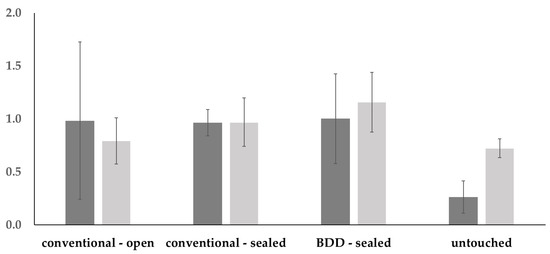
Figure 5.
Mean values of radiographic measurements given in pixels and standard deviations for measurements of periapical radiolucencies in the vertical (dark grey) and horizontal (light grey) directions relative to the width of the respective root.
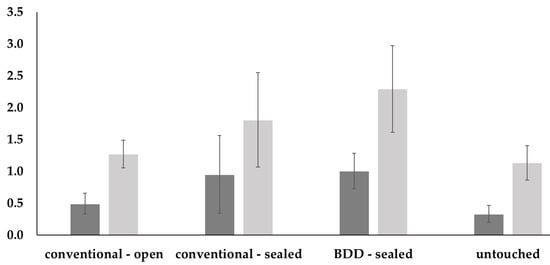
Figure 6.
Mean values of histologic measurements given in µm and standard deviations for measurements of periapical radiolucencies in the vertical (dark grey) and horizontal (light grey) directions relative to the width of the respective root.
The results of the Kruskal–Wallis tests, as well as the pairwise comparisons between the different treatment groups, are given in Table 3 and Table 4 for both vertical and horizontal dimensions of periapical defects as determined radiographically and histologically. Comparing radiographic radiolucency both in the vertical and horizontal directions did not lead to a statistically significant difference among the treatment groups. Based on histologic evaluation, the teeth treated with BDD electrodes showed significantly greater radiolucency as compared to untouched teeth (horizontal direction p = 0.039 and vertical direction p = 0.030). No difference could be seen between the conventionally treated and sealed teeth and teeth treated with BDD electrodes (horizontal direction p = 0.862 and vertical direction p = 0.940).

Table 3.
Comparative statistical analysis for vertical and horizontal radiolucency as determined radiographically. Statistically significant differences p < 0.05 are written in bold.

Table 4.
Comparative statistical analysis for vertical and horizontal radiolucency as determined histologically. Statistically significant differences p < 0.05 are written in bold.
4. Discussion
The series of experiments described in this study aimed to evaluate the risk of host tissue damage during the application of BDD electrodes during root canal treatment. With the working principle of electrochemical disinfection producing unspecific OH radicals, an optimization between bacterial inactivation and cell viability must be achieved for clinical application.
The effect of rinsing solutions such as H2O2, NaOCl, and CHX [21] frequently used in endodontics as well as non-surgical and surgical treatment of peri-implantitis has been studied as a control for cell viability. Regardless of the application mode of the BDD electrodes, cell viability was greater in almost all settings as compared to the use of the rinsing solutions. A possible explanation for this phenomenon may be that the only locally formed radicals during the electrolysis of saline are strictly transient.
Considering proper disinfection of contaminated root canals a prerequisite for periapical healing [2,5] and acknowledging that none of the existing irrigation solutions and protocols can proof superiority [22] electrochemical disinfection using BDD electrodes was envisaged. In a related paper reporting on the same animals, it has been shown that electrochemical disinfection clearly further reduces the bacterial load as compared to conventional endodontic treatment [15]. Despite being aware of the potential differences in oral microbiota being present in humans vs. animals, the bacteria populating infected root canals were not identified as part of this study [23].
With eliminating bacteria being only one aspect of the treatment, this investigation was aimed at roughly evaluating the host response. As a simple indicator, periapical radiolucency was chosen as a parameter comparable to the clinically applicable radiographic periapical index [24,25]. In contrast to the other studies, it was neither possible to determine changes of periapical lesions following the endodontic treatment [1] nor to quantify inflammation [26,27].
Only two out of twelve pairwise comparisons involving teeth treated with BDD electrodes showed significant differences with respect to apical radiolucency. There was no instance where teeth treated conventionally and sealed vs. teeth treated conventionally plus using BDD electrodes and sealed showed a significant difference, indicating that no additional damage had been introduced by electrochemical disinfection. From a clinical perspective, defining successful treatment by the absence of apical periodontitis and clinical symptoms [2], neither of the treatment rendered was successful. In this context, it may also be argued that mechanical instrumentation, only until reaching working length instead of creating apical patency, had led to favorable results. The fact that dog teeth in general do not contain a main apical foramen to connect with the periapical tissues but only an apical delta may be seen as a confounder here. Based on a report indicating that maintaining apical patency did not affect endodontic treatment outcomes in teeth with necrotic pulp and apical periodontitis, it was decided not to overinstrument [28]. As the teeth treated as part of this experiment developed periapical lesions, indicating that no complete healing had occurred regardless of the preparation technique used, it may be seen as an indication that the results presented are nevertheless valid.
As with every animal study, several limitations have to be considered for interpretation. While authors had previously used the same animal model, it may be argued that variations in root canal anatomy were present which had not been identified [6] and which led to radiolucency. Also, the lack of root canal obturation by itself may have caused periapical radiolucency. However, based on a comparable animal study, root canal fillings seem to not enhance periapical healing following chemo-mechanical debridement [3,4]. On the contrary, due to the risk of periapical inflammation caused by the overfilling of root canals [19,29] because of an inability to properly determine apical constriction [30], the decision was made not to perform root canal obturation in the animal trial. Regarding radiographic analysis, it should be kept in mind that the anterior maxillary teeth used here are positioned in a curve, which may geometrically lead to an underestimation of periapical radiolucency. Previous work in the same animal model [4] aimed at evaluating and resolving periapical radiolucency allowed for the periapical healing of approximately 6 months. This was not carried out here as it was anticipated that potential damage due to the use of BDD electrodes might no longer be detectable.
5. Conclusions
Based on the results obtained, and taking into account that current treatment protocols also cause host tissue damage to a certain extent, it may be concluded that the application of BDD electrodes for the electrochemical disinfection of root canals does not bear a greater risk of tissue damage. Clinical studies are inevitable before this method can be recommended.
Supplementary Materials
The following supporting information can be downloaded at: https://www.mdpi.com/article/10.3390/app13148228/s1, File S1: Checklist of items to be included when reporting animal studies in Endodontology [17].
Author Contributions
Conceptualization, V.P. and M.K. (Matthias Karl); methodology, M.K. (Maximilian Koch); investigation, E.D. and M.K. (Maximilian Koch); resources, M.K. (Matthias Karl) and A.B.; writing—original draft preparation, M.K. (Matthias Karl) and A.B.; writing—review and editing, A.B.; visualization, E.D. and M.K. (Maximilian Koch); supervision, A.B. and M.K. (Matthias Karl); project administration, A.B. and M.K. (Matthias Karl); funding acquisition, A.B. and M.K. (Matthias Karl). All authors have read and agreed to the published version of the manuscript.
Funding
The project was funded by Forschungsgemeinschaft Dental e.V. (Grant No. 01/2020) and the Dr. Rolf M. Schwiete Stiftung (Grant 2020-037).
Institutional Review Board Statement
The studies were conducted in accordance with the Declaration of Helsinki and were approved by the Institutional Review Boards. The “Isolation of microorganisms for multispecies biofilm cultivation” part of the study was approved by the Ethics committee, Approval 159_16B, Medical Faculty, Friedrich-Alexander-Universität Erlangen-Nürnberg, and the “Endodontic disinfection in a canine tooth model” part of the study was approved by Comitetului de Etica a Cercetarii, State Medical and Pharmaceutical University “Nicolae Testemitanu”, Chisinau, Moldova.
Informed Consent Statement
Not applicable.
Data Availability Statement
Raw data will be provided by the authors on request.
Acknowledgments
The animal experiments were carried out in part by Elena Demmer in partial fulfillment of the requirements for a degree, Dr. med. dent., at Saarland University, Homburg, Germany. The authors wish to thank Dr. Friedrich Graef, Professor emeritus, the Department of Mathematics, and Friedrich-Alexander-Universität Erlangen-Nürnberg for statistical data analysis. We acknowledge support by the Deutsche Forschungsgemeinschaft (DFG, German Research Foundation) and Saarland University within the funding programme Open Access Publishing.
Conflicts of Interest
The authors A.B. and M.K. (Matthias Karl) disclose a conflict of interest as inventors of BDD electrodes for dental applications.
References
- Khandelwal, A.; Janani, K.; Teja, K.; Jose, J.; Battineni, G.; Riccitiello, F.; Valletta, A.; Palanivelu, A.; Spagnuolo, G. Periapical healing following root canal treatment using different endodontic sealers: A systematic review. Biomed. Res. Int. 2022, 2022, 3569281. [Google Scholar] [CrossRef] [PubMed]
- Bergenholtz, G. Assessment of treatment failure in endodontic therapy. J. Oral Rehabil. 2016, 43, 753–758. [Google Scholar] [CrossRef] [PubMed]
- Li, G.H.; Niu, L.N.; Zhang, W.; Olsen, M.; De-Deus, G.; Eid, A.A.; Chen, J.H.; Pashley, D.H.; Tay, F.R. Ability of new obturation materials to improve the seal of the root canal system: A review. Acta Biomater. 2014, 10, 1050–1063. [Google Scholar] [CrossRef]
- Sabeti, M.A.; Nekofar, M.; Motahhary, P.; Ghandi, M.; Simon, J.H. Healing of apical periodontitis after endodontic treatment with and without obturation in dogs. J. Endod. 2006, 32, 628–633. [Google Scholar] [CrossRef] [PubMed]
- Signoretti, F.G.; Endo, M.S.; Gomes, B.P.; Montagner, F.; Tosello, F.B.; Jacinto, R.C. Persistent extraradicular infection in root-filled asymptomatic human tooth: Scanning electron microscopic analysis and microbial investigation after apical microsurgery. J. Endod. 2011, 37, 1696–1700. [Google Scholar] [CrossRef]
- Silva, E.J.; Castro, R.W.; Nejaim, Y.; Silva, A.I.; Haiter-Neto, F.; Silberman, A.; Cohenca, N. Evaluation of root canal configuration of maxillary and mandibular anterior teeth using cone beam computed tomography: An in-vivo study. Quintessence Int. 2016, 47, 19–24. [Google Scholar]
- Lendini, M.; Alemanno, E.; Migliaretti, G.; Berutti, E. The effect of high-frequency electrical pulses on organic tissue in root canals. Int. Endod. J. 2005, 38, 531–538. [Google Scholar] [CrossRef]
- Barbato, L.; Cavalcanti, R.; Rupe, C.; Scartabelli, D.; Serni, L.; Chambrone, L.; Cairo, F. Clinical efficacy of adjunctive methods for the non-surgical treatment of peri-implantitis: A systematic review and meta-analysis. BMC Oral Health 2023, 23, 375. [Google Scholar] [CrossRef]
- Schneider, S.; Rudolph, M.; Bause, V.; Terfort, A. Electrochemical removal of biofilms from titanium dental implant surfaces. Bioelectrochemistry 2018, 121, 84–94. [Google Scholar] [CrossRef]
- Ratka, C.; Weigl, P.; Henrich, D.; Koch, F.; Schlee, M.; Zipprich, H. The effect of in vitro electrolytic cleaning on biofilm-contaminated implant surfaces. J. Clin. Med. 2019, 8, 1397. [Google Scholar] [CrossRef]
- Schlee, M.; Rathe, F.; Brodbeck, U.; Ratka, C.; Weigl, P.; Zipprich, H. Treatment of peri-implantitis-electrolytic cleaning versus mechanical and electrolytic cleaning-A randomized controlled clinical trial six-month results. J. Clin. Med. 2019, 8, 1909. [Google Scholar] [CrossRef] [PubMed]
- Zipprich, H.; Weigl, P.; Di Gianfilippo, R.; Steigmann, L.; Henrich, D.; Wang, H.L.; Schlee, M.; Ratka, C. Comparison of decontamination efficacy of two electrolyte cleaning methods to diode laser, plasma, and air-abrasive devices. Clin. Oral Investig. 2022, 26, 4549–4558. [Google Scholar] [CrossRef] [PubMed]
- Virto, L.; Odeh, V.; Garcia-Quismondo, E.; Herrera, D.; Palma, J.; Tamimi, F.; Sanz, M. Electrochemical decontamination of titanium dental implants. An in vitro biofilm model study. Clin. Oral Implant. Res. 2023, 34, 486–497. [Google Scholar] [CrossRef]
- Schlee, M.; Naili, L.; Rathe, F.; Brodbeck, U.; Zipprich, H. Is complete re-osseointegration of an infected dental implant possible? Histologic results of a dog study: A short communication. J. Clin. Med. 2020, 9, 235. [Google Scholar] [CrossRef] [PubMed]
- Koch, M.; Palarie, V.; Koch, L.; Burkovski, A.; Zulla, M.; Rosiwal, S.; Karl, M. Preclinical testing of boron-doped diamond electrodes for root canal disinfection-A series of preliminary studies. Microorganisms 2022, 10, 782. [Google Scholar] [CrossRef] [PubMed]
- Martínez-Huitle, C.A.; Brillas, E. A critical review over the electrochemical disinfection of bacteria in synthetic and real wastewaters using a boron-doped diamond anode. Curr. Opin. Solid. State. Mater. Sci. 2021, 25, 100926. [Google Scholar] [CrossRef]
- Nagendrababu, V.; Kishen, A.; Murray, P.E.; Nekoofar, M.H.; Figueiredo, J.A.P.; Priya, E.; Jayaraman, J.; Pulikkotil, S.J.; Camilleri, J.; Silva, R.M.; et al. PRIASE 2021 guidelines for reporting animal studies in Endodontology: A consensus-based development. Int. Endod. J. 2021, 54, 848–857. [Google Scholar] [CrossRef]
- Koch, M.; Burkovski, A.; Zulla, M.; Rosiwal, S.; Geißdörfer, W.; Dittmar, R.; Grobecker-Karl, T. Pilot study on the use of a laser-structured double diamond electrode (DDE) for biofilm removal from dental implant surfaces. J. Clin. Med. 2020, 9, 3036. [Google Scholar] [CrossRef]
- Borlina, S.C.; de Souza, V.; Holland, R.; Murata, S.S.; Gomes-Filho, J.E.; Dezan, E., Jr.; Marion, J.J.; Neto Ddos, A. Influence of apical foramen widening and sealer on the healing of chronic periapical lesions induced in dogs’ teeth. Oral Surg. Oral Med. Oral Pathol. Oral Radiol. Endod. 2010, 109, 932–940. [Google Scholar] [CrossRef]
- Donath, K.; Breuner, G. A method for the study of undecalcified bones and teeth with attached soft tissues. The Säge-Schliff (sawing and grinding) technique. J. Oral Pathol. Med. 1982, 11, 318–326. [Google Scholar] [CrossRef]
- Meister, T.L.; Brüggemann, Y.; Todt, D.; Conzelmann, C.; Müller, J.A.; Groß, R.; Münch, J.; Krawczyk, A.; Steinmann, J.; Steinmann, J.; et al. Virucidal efficacy of different oral rinses against severe acute respiratory syndrome coronavirus 2. J. Infect. Dis. 2020, 222, 1289–1292. [Google Scholar] [CrossRef]
- Beus, C.; Safavi, K.; Stratton, J.; Kaufman, B. Comparison of the effect of two endodontic irrigation protocols on the elimination of bacteria from root canal system: A prospective, randomized clinical trial. J. Endod. 2012, 38, 1479–1483. [Google Scholar] [CrossRef] [PubMed]
- Rôças, I.N.; Hülsmann, M.; Siqueira, J.F., Jr. Microorganisms in root canal-treated teeth from a German population. J. Endod. 2008, 34, 926–931. [Google Scholar] [CrossRef] [PubMed]
- Huumonen, S.; Lenander-Lumikari, M.; Sigurdsson, A.; Orstavik, D. Healing of apical periodontitis after endodontic treatment: A comparison between a silicone-based and a zinc oxide-eugenol-based sealer: Apical periodontitis and sealers. Int. Endod. J. 2003, 36, 296–301. [Google Scholar] [CrossRef] [PubMed]
- Zanini, M.; Decerle, N.; Hennequin, M.; Cousson, P.Y. Revisiting Orstavik’s PAI score to produce a reliable and reproducible assessment of the outcomes of endodontic treatments in routine practice. Eur. J. Dent. Educ. 2021, 25, 291–298. [Google Scholar] [CrossRef]
- Leonardo, M.R.; Silva, L.A.; Utrilla, L.S.; Assed, S.; Ether, S.S. Calcium hydroxide root canal sealers--histopathologic evaluation of apical and periapical repair after endodontic treatment. J. Endod. 1997, 23, 428–432. [Google Scholar] [CrossRef]
- Gomes-Filho, J.E.; Watanabe, S.; Cintra, L.T.; Nery, M.J.; Dezan-Júnior, E.; Queiroz, I.O.; Lodi, C.S.; Basso, M.D. Effect of MTA-based sealer on the healing of periapical lesions. J. Appl. Oral Sci. 2013, 21, 235–242. [Google Scholar] [CrossRef]
- Arslan, H.; Doğanay Yıldız, E.; Topçuoğlu, H.S.; Tepecik, E.; Ayaz, N. Success of maintaining apical patency in teeth with periapical lesion: A randomized clinical study. Quintessence Int. 2019, 50, 686–693. [Google Scholar]
- Bernáth, M.; Szabó, J. Tissue reaction initiated by different sealers. Int. Endod. J. 2003, 36, 256–261. [Google Scholar] [CrossRef]
- Wu, M.K.; Wesselink, P.R.; Walton, R.E. Apical terminus location of root canal treatment procedures. Oral Surg. Oral Med. Oral Pathol. Oral Radiol. Endod. 2000, 89, 99–103. [Google Scholar] [CrossRef]
Disclaimer/Publisher’s Note: The statements, opinions and data contained in all publications are solely those of the individual author(s) and contributor(s) and not of MDPI and/or the editor(s). MDPI and/or the editor(s) disclaim responsibility for any injury to people or property resulting from any ideas, methods, instructions or products referred to in the content. |
© 2023 by the authors. Licensee MDPI, Basel, Switzerland. This article is an open access article distributed under the terms and conditions of the Creative Commons Attribution (CC BY) license (https://creativecommons.org/licenses/by/4.0/).